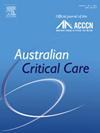Nonpharmacological interventions to promote sleep in the adult critical patients unit: A scoping review
IF 2.6
3区 医学
Q2 CRITICAL CARE MEDICINE
引用次数: 0
Abstract
Background
Sleep and circadian rhythms are markedly altered in intensive care unit (ICU) patients. Numerous factors related to the patient and the ICU environment affect the ability to initiate and maintain sleep. Therefore, nonpharmacological interventions could play an essential role in improving sleep and circadian rhythm.
Objective
The aim of this study was to examine nonpharmacological interventions evaluated for promoting sleep in adult ICUs.
Methods
A scoping review was conducted, including randomised controlled trials, nonrandomised controlled trials, quasi-experimental trials, and other controlled studies investigating the effects of nonpharmacological interventions promoting sleep in adult ICU patients.
Results
A total of 57 articles and 14 ongoing trials were included in the review, of which 38 were randomised clinical trials. Nine nonpharmacological interventions to improve sleep in critically ill patients were evaluated: earplugs and/or eye masks, aromatherapy, bundles, music intervention, massage or acupressure, noise masking, bright light, and dynamic light. Most included trials simultaneously assessed the effect of more than one intervention on perceived sleep quality using questionnaires. The association between the interventions and improved sleep varied. In the case of multicomponent interventions, it is difficult to identify which components might have influenced sleep improvement.
Conclusions
Numerous studies have evaluated various nonpharmacological interventions to promote sleep in critically ill patients, several of which improved perceived sleep quality. However, the substantial variability of the assessed interventions and their implementation complicates drawing reliable conclusions.
Registration
The protocol for this scoping review was registered with the Open Science Framework under the identifier https://doi.org/10.17605/OSF.IO/MPEQ5.
促进成人危重病人睡眠的非药物干预:范围综述。
背景:重症监护病房(ICU)患者的睡眠和昼夜节律明显改变。与患者和ICU环境相关的许多因素都会影响患者启动和维持睡眠的能力。因此,非药物干预可能在改善睡眠和昼夜节律方面发挥重要作用。目的:本研究的目的是评估非药物干预对促进成人icu患者睡眠的作用。方法:纳入随机对照试验、非随机对照试验、准实验试验和其他对照研究,探讨非药物干预促进ICU成人患者睡眠的效果。结果:共纳入57篇文献和14项正在进行的试验,其中38项为随机临床试验。评估了九种改善危重患者睡眠的非药物干预措施:耳塞和/或眼罩、芳香疗法、捆绑疗法、音乐干预、按摩或指压、噪音掩蔽、强光和动态光。大多数纳入的试验同时评估了一种以上干预措施对感知睡眠质量的影响,采用问卷调查。干预与改善睡眠之间的关系各不相同。在多成分干预的情况下,很难确定哪些成分可能影响睡眠改善。结论:大量研究评估了各种促进危重患者睡眠的非药物干预措施,其中一些改善了感知睡眠质量。然而,评估的干预措施及其实施的巨大可变性使得出可靠的结论变得复杂。注册:本次范围审查的协议已在开放科学框架注册,标识符为https://doi.org/10.17605/OSF.IO/MPEQ5。
本文章由计算机程序翻译,如有差异,请以英文原文为准。
求助全文
约1分钟内获得全文
求助全文
来源期刊

Australian Critical Care
NURSING-NURSING
CiteScore
4.90
自引率
9.10%
发文量
148
审稿时长
>12 weeks
期刊介绍:
Australian Critical Care is the official journal of the Australian College of Critical Care Nurses (ACCCN). It is a bi-monthly peer-reviewed journal, providing clinically relevant research, reviews and articles of interest to the critical care community. Australian Critical Care publishes peer-reviewed scholarly papers that report research findings, research-based reviews, discussion papers and commentaries which are of interest to an international readership of critical care practitioners, educators, administrators and researchers. Interprofessional articles are welcomed.
 求助内容:
求助内容: 应助结果提醒方式:
应助结果提醒方式:


